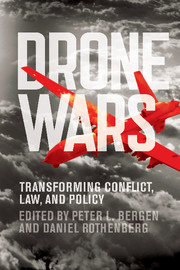Book contents
- Frontmatter
- Contents
- Contributors
- Acknowledgments
- Introduction
- Part I Drones on the Ground
- Part II Drones and the Laws of War
- 6 It Is War at a Very Intimate Level
- 7 This Is Not War by Machine
- 8 Regulating Drones
- 9 A Move Within the Shadows
- 10 Defending the Drones
- Part III Drones and Policy
- Part IV Drones and the Future of War
- Index
- References
9 - A Move Within the Shadows
Will JSOC’s Control of Drones Improve Policy?
Published online by Cambridge University Press: 05 December 2014
- Frontmatter
- Contents
- Contributors
- Acknowledgments
- Introduction
- Part I Drones on the Ground
- Part II Drones and the Laws of War
- 6 It Is War at a Very Intimate Level
- 7 This Is Not War by Machine
- 8 Regulating Drones
- 9 A Move Within the Shadows
- 10 Defending the Drones
- Part III Drones and Policy
- Part IV Drones and the Future of War
- Index
- References
Summary
JSOC and Drone Operations
Lethal drone operations have become a staple of US counterterrorism, and some US policymakers and observers believe that this strategy is likely to increase over the next decade. While much of the criticism of the drone campaign has focused on the covert and possibly illegal actions of the CIA, there has been very little public discussion of the significant and complex role of the Joint Special Operations Command (JSOC) in targeted killings. This is significant because a common misconception presents the US drone strategy as falling into two distinct programs: the conventional military’s overt drone strikes in Afghanistan, and the CIA’s covert strikes in Pakistan and Yemen. In fact, JSOC has worked alongside the CIA in Yemen and perhaps in Pakistan, although the character of their cooperation appears to depend on the particular theater and perhaps even the specific operations. What is clear from limited US government disclosures – mostly in the form of leaks to the press – is that JSOC has been involved in lethal targeting operations across the globe.
This is very significant in that JSOC is a military organization that works alongside the CIA. Yet it is neither part of the conventional military nor wholly akin to the CIA. It is a highly secretive military organization with a record of human rights abuses, possibly resulting from a distinctive culture and dubious relationship to international humanitarian law (also known as the Law of Armed Conflict, or LOAC), which defines clear rules governing the conventional military. Understanding US policy regarding drones requires a deeper consideration of JSOC and its role in these programs. This is because this element of the US military enjoys expansive authority, is increasingly convergent with the CIA, apparently lacks adherence to LOAC, and suggests a new less legally bound projection of military force that creates a variety of ethical and policy concerns.
- Type
- Chapter
- Information
- Drone WarsTransforming Conflict, Law, and Policy, pp. 160 - 184Publisher: Cambridge University PressPrint publication year: 2014
References
- 1
- Cited by



